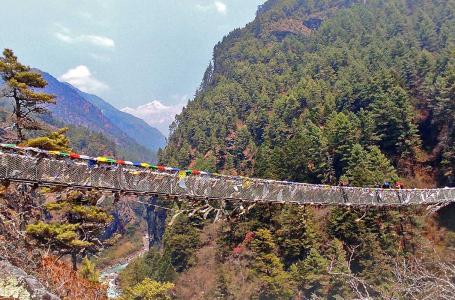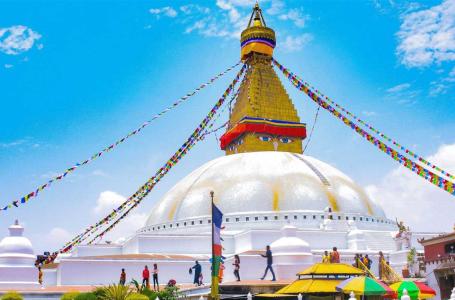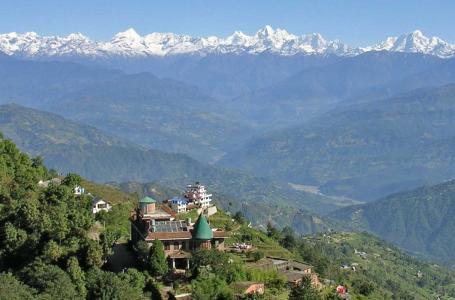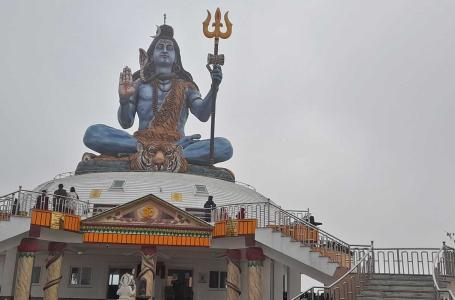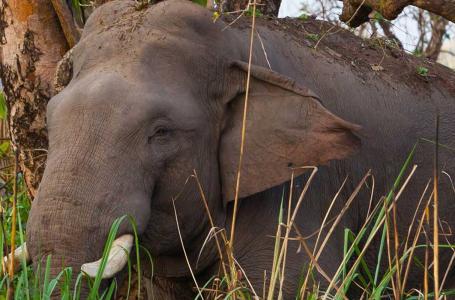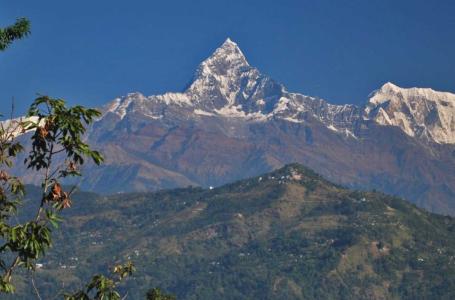Ama Dablam, often called the "Matterhorn of the Himalayas," is one of the most sought-after and technical peaks in the Everest region of northeastern Nepal. Rising majestically to 6,812 meters, it towers over the Imja Valley and is located just a few kilometers south of the legendary Mt. Everest. Its distinct hanging glacier on the southwest face resembles a sacred ornament box, called a "Dablam," traditionally worn by Sherpa women. This striking feature gives the mountain its name, "Ama Dablam," which has become synonymous with both beauty and technical difficulty in the world of mountaineering.
The standard route to the summit of Ama Dablam is via the southwestern ridge, a path first successfully climbed by climbers from New Zealand and the USA in 1961. The expedition typically involves setting up multiple camps, with the base camp located just below the hanging glacier. The climb begins relatively easily up to Camp I, but from there, the terrain becomes more demanding. The section between Camp I and Camp II presents narrow ridges and technical rockwork that requires advanced climbing skills. The climb becomes even more challenging as you ascend from Camp II to Camp III, requiring careful attention to both physical and mental endurance.
Though the risk of avalanches has reduced in recent years, the possibility of falling rocks still exists, making safety gear, including helmets and harnesses, essential. As a climber, having previous experience in alpine climbing or trekking in Nepal is highly recommended before embarking on this challenging expedition.
The Ama Dablam Expedition is perfect for those with prior climbing experience who are ready to tackle high-altitude climbs. If you’re captivated by the panoramic vistas of the Khumbu region, which include some of the tallest peaks in the world like Mt. Everest, Lhotse, and Makalu, then this expedition offers the ultimate challenge. The trek also offers a unique opportunity to immerse yourself in the Sherpa culture, as you pass through villages such as Lukla, Namche Bazaar, and Tengboche.
You’ll also have the chance to explore Sagarmatha National Park, home to rare species of flora and fauna, while trekking through landscapes that are nothing short of spectacular. If you're someone who thrives in rugged mountain environments and is eager to experience both natural beauty and cultural history, the Ama Dablam Expedition will be an unforgettable experience.
The most favorable seasons for the Ama Dablam Expedition are during spring and autumn. These periods offer the clearest skies, allowing climbers to enjoy uninterrupted views of the surrounding peaks, including Mt. Everest and Makalu. The weather conditions during these months are typically stable, which is crucial for high-altitude climbing. Furthermore, the hills along the trail will be adorned with colorful wildflowers, and the rivers will be clear and sparkling. This is also the time when flights to and from Lukla—the gateway to the Everest region—are least likely to be delayed or canceled, ensuring a smoother journey.
To embark on the Ama Dablam Expedition, climbers must secure a range of permits. The most important of these is the Climbing Permit, issued by the Nepal Mountaineering Association (NMA). This permit is specifically for Ama Dablam, as it is classified as a technical climbing peak. Additionally, trekkers will need a Sagarmatha National Park entry permit and a TIMS (Trekkers' Information Management System) card, which are required for all trekking and climbing activities within the Everest region. These permits ensure that trekkers and climbers are following legal routes, and the fees contribute to the conservation of the park and the local community's development.
It’s also important to note that climbers should work with a licensed guide and agency, like Trek Mania Nepal, to facilitate the procurement of these permits, ensuring all paperwork is handled correctly and efficiently before the journey begins.
Standing at 6,812 meters atop Ama Dablam offers a 360-degree panoramic view of the entire Khumbu region, with vistas of the world's most iconic peaks like Everest, Lhotse, Makalu, and Pumori. Along the way, you’ll pass through Sherpa villages such as Phakding, Namche Bazaar, and Pangboche, each offering a glimpse into the unique culture, traditions, and way of life of the Sherpa people.
The trek also takes you alongside the Dudh Koshi River, where the rushing water provides a natural soundtrack to your journey. As you pass through Sagarmatha National Park, you’ll encounter the rare flora and fauna that call this UNESCO World Heritage Site home, including the elusive snow leopard and red panda. The exhilarating mountain flight to and from Lukla adds an extra layer of adventure to the entire expedition, providing breathtaking views of the surrounding peaks as you land in one of the world’s most famous and dramatic airports.
For climbers looking for a combination of technical challenges, stunning mountain views, and a chance to immerse themselves in the unique Sherpa culture, the Ama Dablam Expedition is unparalleled. Whether you're drawn to the adrenaline rush of summit attempts or simply want to experience the serene beauty of the Khumbu region, this expedition offers it all. The journey through Sagarmatha National Park, the iconic flight to Lukla, and the opportunity to stand on the summit of one of the most beautiful mountains in the world makes this an experience you won’t soon forget.
For more information on expeditions like this, visit Trek Mania Nepal and plan your next great adventure.
Upon your arrival in Kathmandu, you'll be greeted by the bustling streets and rich cultural tapestry of Nepal's capital. Take some time to settle in, perhaps exploring the bustling streets of Thamel or visiting one of Kathmandu's many historic sites. Dive into the city's vibrant culture by sampling traditional Nepali cuisine at a local restaurant, or immersing yourself in the sights and sounds of Durbar Square, where ancient temples and palaces stand as a testament to Nepal's rich heritage.
Experience the exhilarating flight from Kathmandu to Lukla, where the adventure truly begins. The flight offers breathtaking views of the Himalayas, including glimpses of iconic peaks such as Everest and Ama Dablam. Upon landing in Lukla, you'll meet your trekking team and set off on a scenic trek to Phakding. The trail winds through picturesque villages and lush forests, with the sound of the Dudh Koshi River accompanying your journey. Keep an eye out for prayer flags fluttering in the breeze and colorful Mani stones carved with Buddhist prayers along the way.
Today's trek takes you deeper into the heart of the Khumbu region as you make your way to Namche Bazaar, the bustling hub of the Everest region. The trail ascends gradually, offering stunning views of snow-capped peaks and verdant valleys. Cross suspension bridges adorned with prayer flags and pass through rhododendron forests alive with the sound of birdsong. As you approach Namche Bazaar, catch your first glimpse of Everest and the surrounding Himalayan giants. Arriving in Namche, immerse yourself in the vibrant atmosphere of the town, exploring its bustling markets, quaint tea houses, and ancient monasteries.
Take a well-deserved rest day in Namche Bazaar to acclimatize to the altitude and prepare for the challenges ahead. Rise early and embark on a hike to the Everest View Hotel, perched on a ridge above Namche. From here, enjoy panoramic views of Everest, Lhotse, and Ama Dablam, soaking in the breathtaking beauty of the Himalayas. Explore the narrow alleys and winding streets of Namche, where colorful prayer flags flutter in the breeze and the aroma of freshly brewed coffee fills the air. Visit the Sherpa Museum to learn about the rich cultural heritage of the Sherpa people and their traditional way of life in the mountains.
Resume your trek, leaving the bustling streets of Namche behind as you journey deeper into the mountains. The trail climbs steeply out of Namche, offering sweeping views of the surrounding peaks and valleys. Pass through charming Sherpa villages and terraced fields, where yaks graze peacefully in the meadows.
As you approach Pangboche, the imposing peak of Ama Dablam comes into view, dominating the skyline with its majestic beauty. Arrive in Pangboche, where the rich Sherpa culture and warm hospitality welcome you with open arms. Visit the ancient monastery, adorned with colorful prayer flags and intricately carved wooden architecture, and immerse yourself in the spiritual ambiance of the Himalayas.
Embark on a challenging trek to Ama Dablam Base Camp, where your expedition officially begins. The trail winds through rugged terrain and rocky moraines, offering stunning views of Ama Dablam's towering summit. As you approach the base camp, catch your first glimpse of the iconic pyramid-shaped peak, rising majestically above the surrounding glaciers. Settle into base camp and prepare for the days ahead, soaking in the serene beauty of the Himalayan wilderness.
Participate in a traditional worshipping ceremony at Ama Dablam Base Camp, seeking blessings for a safe and successful climb. Immerse yourself in Sherpa culture and spiritual traditions as you pay homage to the sacred mountains that surround you.
The ceremony is a deeply symbolic and spiritual experience, reinforcing the connection between climbers and the natural world. Take this opportunity to reflect on the significance of your journey and the challenges that lie ahead, drawing strength and inspiration from the ancient rituals of the Himalayas.
Begin your ascent of Ama Dablam, climbing to Camp I at an altitude of 5,700m. The climb is steep and technical, requiring concentration and skill as you navigate rocky terrain and icy slopes. Upon reaching Camp I, establish your camp and take in the breathtaking views of the surrounding mountains. Spend some time acclimatizing to the altitude before descending back to base camp for a well-deserved rest.
Return to Camp I and spend the night, preparing for the next stage of your climb. The route to Camp I offers spectacular views of the surrounding peaks, with Ama Dablam towering overhead. As you ascend, you'll pass through a dramatic landscape of ice and rock, with the sound of crampons crunching on the frozen terrain echoing in the crisp mountain air. Arrive at Camp I and settle into your high-altitude camp, enjoying the camaraderie of your fellow climbers and the sense of accomplishment that comes with reaching new heights.
Push onwards to Camp II at an altitude of 6,000m, navigating steep rock faces and icy slopes. The climb is challenging and exhilarating, requiring focus and determination to overcome. As you ascend, take in the breathtaking views of the surrounding peaks and glaciers, with the summit of Ama Dablam looming ever closer. Upon reaching Camp II, enjoy a brief rest before descending back to base camp, where hot meals and warm sleeping bags await.
Take a well-deserved rest day at base camp, allowing your body to recover and recharge for the challenges ahead. The rest day is essential for acclimatization and ensures that you're in peak physical condition for the summit push. Spend the day relaxing in camp, reading a book, or simply soaking in the stunning mountain scenery. Reflect on your journey so far.
Return to Camp I in preparation for your summit bid. The climb back to Camp I is familiar yet challenging, with steep terrain and icy conditions testing your climbing skills and endurance. As you ascend, take in the breathtaking views of the surrounding mountains, with Ama Dablam standing tall against the backdrop of the Himalayan sky. Arrive at Camp I and settle in for the night, readying yourself for the final push to the summit.
Continue your ascent to Camp II, situated at 6,000m above sea level. The climb is physically demanding, with steep terrain and technical challenges testing your strength and stamina. As you ascend, take in the awe-inspiring beauty of the Himalayan landscape, with panoramic views of snow-capped peaks and rugged glaciers stretching as far as the eye can see. Arrive at Camp II and prepare for the final push to the summit, knowing that your goal is within reach.
Today is the culmination of your journey as you embark on the ultimate summit push. Rise before dawn and begin the challenging climb to the summit of Ama Dablam, reaching heights of over 6,800 meters above sea level. The climb is physically demanding, with steep terrain and icy conditions requiring focus and determination. As you ascend, take in the breathtaking beauty of the Himalayas unfolding around you, with panoramic views of Everest, Lhotse, and Makalu stretching to the horizon.
Arrive at the summit and celebrate your achievement, knowing that you've conquered one of the world's most iconic peaks. After a brief rest, begin the descent back to Camp II, where hot meals and warm sleeping bags await. Reflect on your journey as you make your way back to camp, knowing that you've left your mark on the Himalayan landscape and forged memories that will last a lifetime.
Use this day as a contingency in case of inclement weather or other unforeseen circumstances. The mountains are unpredictable, and it's essential to stay flexible and adaptable to ensure a safe and successful climb. If the weather permits, take the opportunity to explore the surrounding area or relax in camp, reflecting on your achievements and savoring the sense of accomplishment that comes with summiting Ama Dablam.
Begin your descent from the higher camps back to Ama Dablam Base Camp, taking in the stunning views of the surrounding mountains and glaciers. The descent is physically demanding, with steep terrain and rocky paths requiring careful footing and concentration.
As you make your way back to base camp, take time to reflect on your journey and the challenges you've overcome, knowing that you've left your mark on the Himalayan landscape. Arrive at base camp and celebrate your accomplishments with your fellow climbers, enjoying a well-deserved rest before beginning the journey back to civilization.
Embark on the return trek to Namche Bazaar, retracing your steps through the breathtaking landscapes of the Khumbu region. The trail winds through lush forests and picturesque villages, with the sound of the Dudh Koshi River accompanying your journey.
Take time to appreciate the natural beauty of the Himalayas and the warm hospitality of the Sherpa people as you make your way back to civilization. Arrive in Namche Bazaar and enjoy a hot meal and a comfortable bed, knowing that you're one step closer to the comforts of home.
Continue your descent to Lukla, where you'll conclude your expedition. The trail winds through rhododendron forests and past quaint villages, offering stunning views of the surrounding mountains. As you approach Lukla, take in the sights and sounds of this bustling mountain town, filled with trekkers and climbers from around the world.
Arrive in Lukla and celebrate your accomplishments with your team, enjoying a well-deserved meal and perhaps a hot shower before departing for Kathmandu.
Board a scenic flight from Lukla back to Kathmandu, marking the end of your Ama Dablam Expedition. The flight offers breathtaking views of the Himalayas, providing a fitting finale to your journey. Arrive in Kathmandu and take some time to relax and unwind, perhaps exploring the city's vibrant markets or visiting one of its many historic sites. Enjoy a farewell dinner with your team, sharing stories and memories of your epic adventure in the mountains.
Bid farewell to Nepal as you board your international flight home, carrying with you memories of adventure, friendship, and triumph in the shadow of the mighty Ama Dablam. Reflect on your journey and the lessons you've learned along the way, knowing that you've accomplished something truly remarkable. Depart with a sense of gratitude for the experiences you've had and the people you've met, knowing that the mountains will always be there, calling you back to explore their beauty once again.
Trip Start and End Point
Kathmandu / Kathmandu
| DATES | STATUS | PRICE | SPACE LEFT | ||||
|---|---|---|---|---|---|---|---|
|
Start date: 23-May, 2025
End date: 11-Jun, 2025 |
Guaranteed | USD 4500 |
1
|
Book Now | |||
|
Start date: 07-Jun, 2025
End date: 26-Jun, 2025 |
Guaranteed | USD 4500 |
2
|
Book Now | |||
|
Start date: 21-Aug, 2025
End date: 09-Sep, 2025 |
Guaranteed | USD 4500 |
2
|
Book Now | |||
|
Start date: 05-Sep, 2025
End date: 24-Sep, 2025 |
Guaranteed | USD 4500 |
3
|
Book Now | |||
|
Start date: 17-Sep, 2025
End date: 06-Oct, 2025 |
Guaranteed | USD 4500 |
2
|
Book Now | |||
|
Start date: 05-Oct, 2025
End date: 24-Oct, 2025 |
Guaranteed | USD 4500 |
3
|
Book Now | |||
Head
Upper Body
Hands
Lower Body
Feet
Sleeping Gear
Personal Climbing Gear
Group Climbing Gear
Baggage
Medical
Practical Items
Toiletries
Personal Hygiene
Extras/Luxuries
Climbing Ama Dablam is considered a technically challenging expedition, suitable for experienced mountaineers. The route involves steep ridges, ice, and rock climbing, requiring advanced technical skills. Previous experience in high-altitude climbing is essential for summit attempts.
Yes, previous experience in alpine climbing or trekking peaks is highly recommended for the Ama Dablam Expedition. The climb involves technical sections and requires good physical fitness, stamina, and knowledge of high-altitude environments.
Essential climbing gear for the Ama Dablam Expedition includes ice axes, crampons, climbing boots, ropes, helmets, harnesses, and personal safety gear. We recommend checking with your expedition guide for a complete gear list before departure.
The Ama Dablam summit push typically takes around 16 to 18 days, depending on acclimatization, weather conditions, and the climber's pace. This includes time for rest, acclimatization at Base Camp, and establishing high-altitude camps.
Yes, altitude sickness is a concern for any high-altitude climb, including Ama Dablam. Proper acclimatization is critical. Climbers will spend several days at intermediate elevations like Namche Bazaar and Pangboche to allow the body to adjust to the thinner air before attempting the summit.
For the Ama Dablam Expedition, climbers require a Sagarmatha National Park permit, an Everest region climbing permit, and a local area permit. These permits can be arranged through your trekking agency, like Trek Mania Nepal.
Both group expeditions and private expeditions are available for the Ama Dablam climb. Group climbs can be more affordable, while private climbs offer more flexibility and personalized attention. Discuss your preferences with your trekking agency.
The best seasons for the Ama Dablam Expedition are spring (March to May) and autumn (September to November). During these times, the weather is stable, skies are clear, and the conditions are optimal for climbing. Winter and summer seasons are generally not recommended due to snowstorms and extreme cold.
Yes, Ama Dablam involves rock climbing, ice climbing, and navigating narrow ridges, all of which require technical climbing skills. Climbers should be comfortable with rope handling, using crampons, and handling steep ascents.
Ama Dablam's breathtaking beauty, technical challenge, and stunning views of the Himalayas, including Mount Everest, make it one of the most sought-after climbing expeditions in Nepal. It is often referred to as the "Matterhorn of the Himalayas" due to its distinctive shape and striking presence in the Khumbu region.

